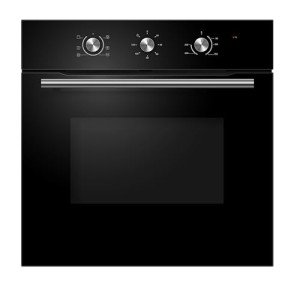16 Must-Follow Facebook Pages To Ovens Built In-Related Businesses

The Rise of Built-in Electric Ovens: Enhancing Kitchens with Style and Functionality
As modern-day kitchen areas develop to end up being more than just a location for cooking, the demand for appliances that seamlessly mix design and function has increased. Among the most desired kitchen appliances in modern homes is the built-in electric oven. This short article explores the advantages, features, and factors to consider when picking built-in electric ovens, providing homeowners the insights needed to make educated decisions.
What is a Built-in Electric Oven?
A built-in electric oven is an appliance that is installed straight into the kitchen cabinetry instead of being free-standing. This style permits a cleaner, more streamlined look in the kitchen. source web page -in electric ovens can be put at various heights, providing ergonomic benefits and boosting availability for different tasks, consisting of baking, broiling, and roasting.
Secret Features of Built-in Electric Ovens
Built-in electric ovens are packed with functions developed to elevate cooking experiences. These consist of:
- Variability in Styles and Sizes: Available in different designs (single, double, wall) and sizes, built-in ovens can fit any kitchen layout and design.
- Advanced Cooking Technologies: Many designs feature convection cooking, steam cooking, and accuracy temperature controls to enhance cooking efficiency.
- User-Friendly Controls: With digital display screens and touch controls, built-in ovens permit accurate adjustments and cooking timers.
- Self-Cleaning Options: Some built-in electric ovens are equipped with self-cleaning cycles that make upkeep a breeze.
- Smart Technology Integration: Modern built-in ovens might feature smart capabilities, enabling users to keep an eye on cooking from another location by means of mobile phone apps.
Benefits of Built-in Electric Ovens
- Space Efficiency: Built-in electric ovens conserve floor space, making them ideal for smaller kitchen areas where square video is limited. Their design allows for taking full advantage of cabinet space above and below.
- Aesthetic Appeal: The streamlined and integrated look of built-in ovens matches contemporary kitchen styles, offering a smooth shift between appliances and cabinetry.
- Increased Functionality: With various setups (e.g., double ovens), house owners can cook several dishes at various temperatures simultaneously, boosting meal preparation effectiveness.
- Improved Accessibility: Built-in electric ovens can be set up at eye level, making it simpler to inspect on meals without bending down, thereby reducing stress.
- Safety: Built-in ovens are usually created to have solid installation, reducing the risk of tipping over. Additionally, functions like cool-to-the-touch doors improve security, particularly in homes with children.
Picking the Right Built-in Electric Oven
When selecting the best built-in electric oven, different aspects ought to be considered. Here's a checklist of essential criteria:
- Size and Dimensions: Measure the readily available area in the kitchen and ensure the picked oven fits appropriately.
- Capability: Consider the volume of food preparation required for family size or entertaining.
- Cooking Features: Evaluate the particular cooking features required, like convection modes or additional racks.
- Style Preference: Choose in between different styles and surfaces that will match the kitchen's visual.
- Guarantee and Customer Support: Research the producer's guarantee and accessibility of client support for maintenance and repair work.
Contrast of Built-in Electric Ovens
| Feature | Single Built-in Oven | Double Built-in Oven |
|---|---|---|
| Capacity | 3.0 to 5.0 cu. ft. | 6.0 to 10.0 cu. ft. |
| Cost | Typically lower | Higher due to more functions |
| Cooking Versatility | Limited to one dish | Can cook multiple dishes at differing temperatures |
| Energy Efficiency | Generally efficient | May utilize more power due to bigger size |
| Setup Complexity | Simpler | More complex due to additional weight |
Upkeep and Care for Built-in Electric Ovens
To make sure durability and optimal performance, regular upkeep of built-in electric ovens is vital. Here are some tips for care:
- Regular Cleaning: Wipe down surfaces after each use to avoid build-up. Use proper cleaners for the oven interiors and exteriors.
- Inspect Seals and Gaskets: Inspect door seals periodically to guarantee they are intact to maintain cooking effectiveness.
- Calibrate the Oven: Check oven temperature levels with an oven thermometer to ensure it's cooking at the right temperature.
- Follow the Manufacturer's Guidelines: Adhere to operating guidelines supplied by the manufacturer for safe and efficient usage.
FAQs About Built-in Electric Ovens
Q1: Are electric ovens more energy-efficient than gas ovens?A1: Generally, electric ovens can be more energy-efficient since they warm more evenly and preserve temperature better as soon as heated up. However, this can differ based upon usage patterns and specific models. Q2: Can built-in electric ovens be repaired?A2: Yes, built-in electric
ovens can be fixed. However, it is advised to hire professionals for repair work due to the complex setup. Q3: Do built-in ovens take longer to set up compared to freestanding models?A3: Yes, built-in ovens typically require more
intricate setup procedures, which might involve kitchen cabinetry adjustments, electrical circuitry, and leveling. Q4: What is the typical life expectancy of a built-in electric oven?A4: A well-kept built-in electric oven can last in between 10 to 15 years.
Built-in electric ovens are changing kitchens by integrating performance, aesthetic appeal, and sophisticated technology. By thinking about the functions and benefits
, homeowners can make an educated choice for their cooking needs. As culinary patterns shift towards more integrated designs, the built-in electric oven continues to be a staple in contemporary cooking areas, providing both style and substance for cooking enthusiasts all over.

